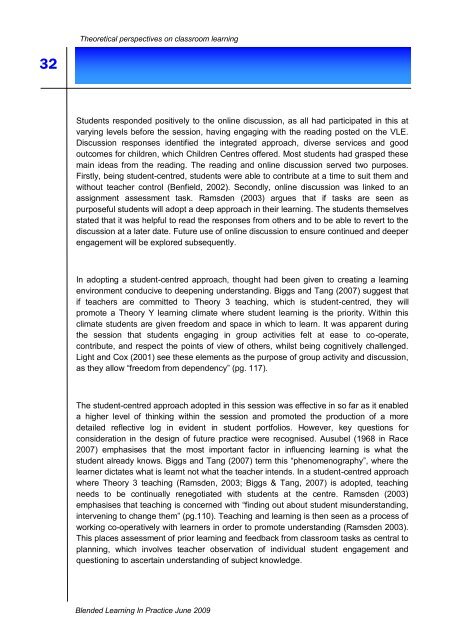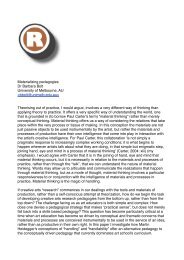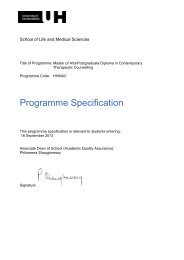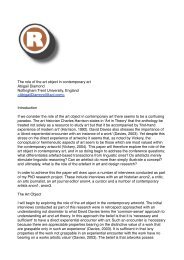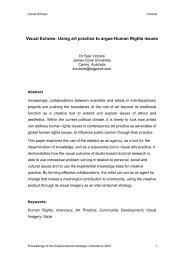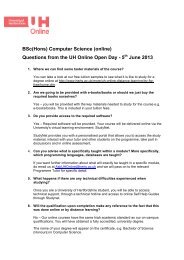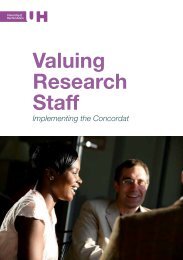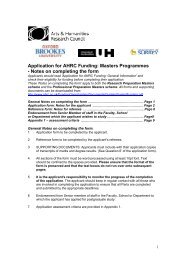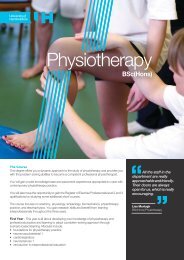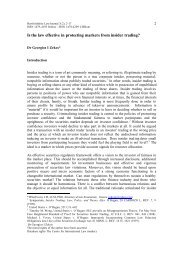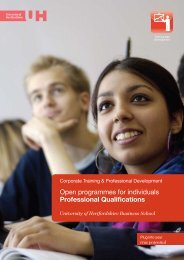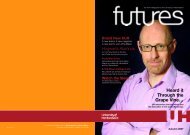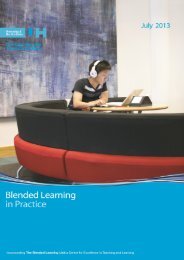June 2009 - University of Hertfordshire
June 2009 - University of Hertfordshire
June 2009 - University of Hertfordshire
You also want an ePaper? Increase the reach of your titles
YUMPU automatically turns print PDFs into web optimized ePapers that Google loves.
Theoretical perspectives on classroom learning<br />
32<br />
Students responded positively to the online discussion, as all had participated in this at<br />
varying levels before the session, having engaging with the reading posted on the VLE.<br />
Discussion responses identified the integrated approach, diverse services and good<br />
outcomes for children, which Children Centres <strong>of</strong>fered. Most students had grasped these<br />
main ideas from the reading. The reading and online discussion served two purposes.<br />
Firstly, being student-centred, students were able to contribute at a time to suit them and<br />
without teacher control (Benfield, 2002). Secondly, online discussion was linked to an<br />
assignment assessment task. Ramsden (2003) argues that if tasks are seen as<br />
purposeful students will adopt a deep approach in their learning. The students themselves<br />
stated that it was helpful to read the responses from others and to be able to revert to the<br />
discussion at a later date. Future use <strong>of</strong> online discussion to ensure continued and deeper<br />
engagement will be explored subsequently.<br />
In adopting a student-centred approach, thought had been given to creating a learning<br />
environment conducive to deepening understanding. Biggs and Tang (2007) suggest that<br />
if teachers are committed to Theory 3 teaching, which is student-centred, they will<br />
promote a Theory Y learning climate where student learning is the priority. Within this<br />
climate students are given freedom and space in which to learn. It was apparent during<br />
the session that students engaging in group activities felt at ease to co-operate,<br />
contribute, and respect the points <strong>of</strong> view <strong>of</strong> others, whilst being cognitively challenged.<br />
Light and Cox (2001) see these elements as the purpose <strong>of</strong> group activity and discussion,<br />
as they allow “freedom from dependency” (pg. 117).<br />
The student-centred approach adopted in this session was effective in so far as it enabled<br />
a higher level <strong>of</strong> thinking within the session and promoted the production <strong>of</strong> a more<br />
detailed reflective log in evident in student portfolios. However, key questions for<br />
consideration in the design <strong>of</strong> future practice were recognised. Ausubel (1968 in Race<br />
2007) emphasises that the most important factor in influencing learning is what the<br />
student already knows. Biggs and Tang (2007) term this “phenomenography”, where the<br />
learner dictates what is learnt not what the teacher intends. In a student-centred approach<br />
where Theory 3 teaching (Ramsden, 2003; Biggs & Tang, 2007) is adopted, teaching<br />
needs to be continually renegotiated with students at the centre. Ramsden (2003)<br />
emphasises that teaching is concerned with “finding out about student misunderstanding,<br />
intervening to change them” (pg.110). Teaching and learning is then seen as a process <strong>of</strong><br />
working co-operatively with learners in order to promote understanding (Ramsden 2003).<br />
This places assessment <strong>of</strong> prior learning and feedback from classroom tasks as central to<br />
planning, which involves teacher observation <strong>of</strong> individual student engagement and<br />
questioning to ascertain understanding <strong>of</strong> subject knowledge.<br />
Blended Learning In Practice <strong>June</strong> <strong>2009</strong>


